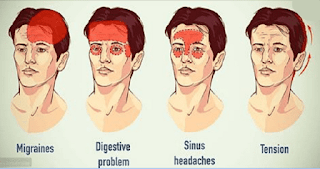The different types of headaches depend upon the class to which they belong. Some common types include:
- Primary tension headaches that are episodic
- Primary tension headaches that are chromic
- Primary muscle contraction headaches
- Primary migraine headaches with aura
- Primary migraine headaches without aura
- Primary cluster headache
- Primary paroxysmal hemicrania (a type of cluster headache)
- Primary cough headache
- Primary stabbing headache
- Primary headache associated with sexual intercourse
- Primary thunderclap headache
- Hypnic headache (headaches that awaken a person from sleep)
- Hemicrania continua (headaches that are persistently on one side only. right or left [unilateral])
- New daily-persistent headache (NDPH) (a type of chronic headache)
- Headache from exertion
- Trigeminal neuralgia and other cranial nerve inflammation
- Secondary headaches due to:
Trauma
Disorders
Infection
Structural problems with the bones of the face, teeth, eyes, ears, nose, sinuses or other structures
Substance abuse or withdrawa













